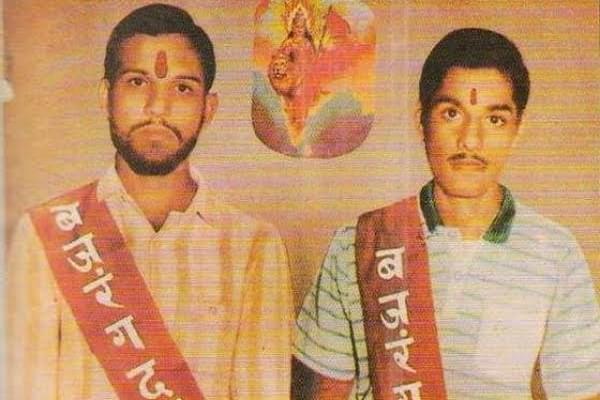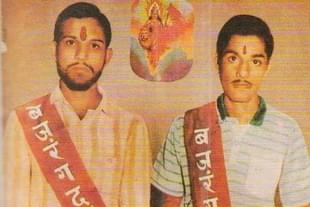Politics
The Sacrifices That Sealed A Commitment — 'Mandir Vahin Banayenge'
Aravindan Neelakandan
Dec 02, 2023, 01:42 PM | Updated Dec 26, 2023, 06:09 PM IST
Save & read from anywhere!
Bookmark stories for easy access on any device or the Swarajya app.


30 October 1990 was not just another day.
It was the day of parikrama at Ayodhya. It was Kartik Poornima.
Lakhs of devotees were to come that day to take a dip in the sacred Sarayu river. However, on this occasion, the familiar parikrama and snana had become a challenge.
The day, 30 October 1990, was also designated for kar seva. The sants and sadhus assembled at Haridwar on 23-24 June had chosen it to be so.
Some of the sants in the June assembly were not happy with the choice of date. It was too far into the future. But the leaders of the Sant Sammelan and the majority of sants were clear — 'We should give governments of our nation, state and central, and our Muslim brothers enough time'. So they reasoned.
In Lucknow, Mulayam Singh Yadav, aiming to overshadow Lalu Yadav's feat of arresting L K Advani, aimed to ensure that no potential kar sevak be allowed into Ayodhya. Perhaps, a few elderly individuals would be allowed, but no more.
This move was intended to highlight the perceived ineffectiveness of sants, sadhus, the Vishva Hindu Parishad (VHP), the Rashtriya Swayamsevak Sangh (RSS), and the Bharatiya Janata Party (BJP) against the might of Mulayam's government.
It's crucial to note that in the broader political context, Mulayam was aligning with Chandrasekhar and Subramanian Swamy, who were working towards forming a government after the fall of the V P Singh government. Hence, Mulayam's actions were seen to have the implicit approval of the Congress under Rajiv Gandhi.
On Mulayam's orders, the Uttar Pradesh administration created a concentric fortress of police around Ayodhya. Five circles of security — all armed with automatic weapons.
The town of Ayodhya resembled a cantonment. ‘Not a bird would be allowed to fly over the masjid’, Mulayam had declared.
He had deployed a strong team of extra officers for the day. The count of police and paramilitary personnel was around 28,000. They were from the companies of the Indo-Tibetan Border Police (ITBP), the Border Security Force (BSF), the Central Reserve Police Force (CRPF), and Uttar Pradesh state police, including the Provincial Armed Constabulary (PAC).
It was 30 October.
Ayodhya was silent, and there was no sign of movement from the kar sevaks. Surely, Mulayam's administration had won. Surely, all plans of kar seva had fizzled out.
Then, the eruption.
Scores of Rama bhaktas were seen in the lanes and by-lanes of Ayodhya.
One particularly charismatic young leader at the forefront was Uma Bharti. She was the one who came up with the phrase 'Rama lalla hum aayenge, mandir vahin banayenge (Infant Rama, we are coming! We will build the mandir there.)'
The police were actively looking for Bharti to take her into preventive custody, with the specific goal of preventing her entry into Ayodhya. Despite their efforts, the young sadhvi managed to evade the police by disguising herself as a young boy.
Meanwhile, Ashok Singhal had reached Ayodhya stealthily on 28 October. He was the VHP leader and the foremost leader of the Rama bhaktas in the movement.
S C Dixit, a former director-general of police in Uttar Pradesh, was also there as a kar sevak.
The police realised that their carefully constructed cordons had been breached. In response, they decided to disperse the crowd with a lathi charge.
Singhal sustained blows to his head, and despite the blood flowing out, he defiantly waved at the Rama bhaktas. Refusing to leave, he continued to lead.
The Rama bhaktas pressed forward, enduring the bamboo sticks that struck each devotee. Remarkably, most kar sevaks refrained from retaliation, responding with the Rama Nama chant.
In a poignant moment emblematic of the day, an elderly man approached the Rama Lalla mandir beneath the domes, only to be halted by the police in one of the narrow lanes.
As the police lathi was poised to strike the elderly man, two young kar sevaks stepped forward, creating a human shield around him. The beatings rained down on the two youths; yet all three — those receiving the beatings and the elderly man under their protection — moved as one, without raising even a finger. Charaiveti! Charaiveti!
All of Ayodhya was resounding with the chant ‘Shri Rama, Jai Rama, Jai Jai Rama’. It had more the tone of a religious chant than a battle cry. The videos that emerged later showcased the remarkable courage displayed by the peaceful Rama Nama chanters in the face of the harsh police treatment.
Seeing the footage, it was evident that many police personnel were visibly affected by the scenes.
The arrests began. But how many could the police arrest?
Those arrested were put on vans and buses and taken around the streets of Ayodhya. A parikrama was unfolding in itself.
Among those arrested was a sadhu, who was a driver in his poorvashrama (pre-sanyasi days). Suddenly, he took the driver's seat on one of the buses. That bus penetrated the final barrier before the Rama janmabhoomi and, upon reaching the destination, the Rama bhaktas disembarked.
'Baccha Baccha Rama ka, Janmabhoomi ke kaam ka!', they chanted. They had come for infant Rama, but they themselves were His children.
An innocent and unrefined state of consciousness, characterised by pure devotion — bhakti in its purest form — animated every soul in the vicinity of the Janmabhoomi.
The police observed the proceedings. Something prevented them from advancing and halting the Rama bhaktas. Swiftly, the kar sevaks ascended the domes and raised the saffron flag from atop.
In Ayodhya, there are more than 50 dargahs, the tomb shrines of Muslim holy men, and many more mosques, not to mention Muslim graveyards. It was in this city that the kar sevaks, fuelled by Rama bhakti and a passion to build the temple, had entered.
They numbered around a lakh. But despite being subjected to severe stress by the state, they resisted any temptation to cause harm to any Islamic places. They had come for the right of their Rama lalla to have His temple. They would concentrate only on that goal.
Meanwhile, an Indian Air Force helicopter appeared in the skies. Many thought that Mulayam Singh Yadav was riding in the chopper and, therefore, hurled their chappals in its direction.
The Bullets
An ITBP personnel fired a shot, clearing the kar sevaks atop the domes. However, the saffron flag soared high. As the police advanced towards the domes to take the flag down, they noticed a lone monkey serenely perched on one of the domes, unfazed by the chaos around.
The policemen halted in their tracks, waiting in reverence. It was only after the monkey departed that the flag was taken down.
Then, the police opened fire.
The firing that day was mainly at Sarayu bridge, near Hanuman Garhi. Some kar sevaks died in the police firing. Spontaneously, a slogan arose — Hindu Hindu, bhai bhai: Beech mein verdi kahan se aayi? (Hindus are all brothers; how can a uniform divide them?)
The Rama wave was slowly getting to the hearts of the uniformed personnel. They had already opened fire. They had already lathi-charged people. But the Rama bhaktas had asked a question.
It was like in 1857 when villagers asked questions about Dharma to the East India Company soldiers.
The Uttar Pradesh police and PAC refrained from further use of force.
On 1 November, when yagnas were held on the banks of Sarayu, resonating with the chants of Rama Nama and readings from the Shri Ramacharitamnas, not just the Rama bhaktas, but even the police personnel and officials of the Uttar Pradesh administration joined in the chants.
In response, the state administration changed the police force overnight. New battalions — entirely CRPF — were brought in.
Then, 2 November 1990 turned into the most shameful day in the history of independent India.
Like before, Rama bhaktas started singing bhajans and marching the streets. But this time, they confronted a new hostile force.
There were no warnings. The firings started almost immediately. Most of the shots hit the bhaktas point blank.
The police's systematic and precise actions, such as attaching sandbags to the bodies of the deceased before dumping them into the sacred Sarayu, betrayed the nature of the directives from the administration.
The Kothari brothers, Sharad Kumar (20) and Ram Kumar (23), had come all the way from Kolkata to participate in Rama seva. They were shot point blank and their bodies dumped outside a building.
Their bodies were recovered and cremated with all honours. In time, they became an emotional symbol for the youths of the 1990s.
In the bright light of the waning Moon, almost as luminous as the light of the poornima, boats moved slowly across the waters of Sarayu, recovering the bodies of Rama bhaktas.
The VHP would not allow them to go unhonoured. Complete cremation rituals with Vedic mantras were arranged. According to the VHP, they alone cremated 70 bodies, but official reports sought to minimise the numbers, to between 15 and 26. The exact number remains unknown.
The duty officer at Sri Ram Hospital of Ayodhya that day was Dr S K Gupta. He would later reveal that most of the bullet wounds on the bodies were from point-blank shots. They were not shot in the lower limbs, but were shots meant to kill.
The indignation felt by the Hindu community was visible.
Here, it is important to express the gratitude for the significant role played by Hindu women. Sitadevi, the wife of V P Singh, was said to have admonished him and asked him to stand by the temple movement.
Further, the wives of Uttar Pradesh police and military officers took out a procession in Faizabad to protest the massacre of kar sevaks by the Mulayam government.
In many places, Hindu families spontaneously observed a day of fasting, and lamps were lit in houses and temples for the slain Rama bhaktas. A sacred commitment was sealed through the blood of the slain.
‘Mandir vahin banayenge’.
This is the sixth piece in the 'Ayodhya 2024' series that Aravindan Neelakandan is writing in the build-up to the inauguration of the Shri Rama Janmabhoomi temple. We will be publishing one article every week. You can read the rest of the pieces in the series here.





